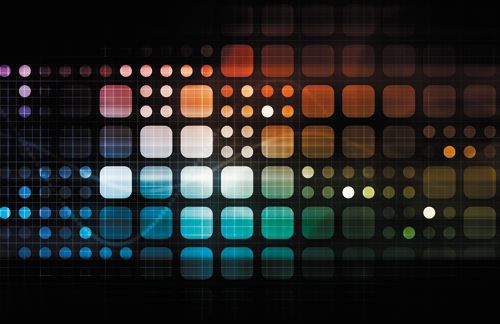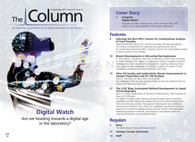Recent Developments in Microchip Electrophoresis
Capillary electrophoresis (CE) is routinely used for chemical and biochemical analysis methods, and recently the technique has been implemented on microchips. R. Scott Martin, a professor and chair of chemistry at Saint Louis University, St. Louis, Missouri, USA, has been investigating ways to improve these techniques for years. He recently spoke to us about his research coupling microchip electrophoresis with electrochemical detection, coupling continuous flow with microchip electrophoresis with valving, coupling microchip CE with microdialysis sampling and electrochemistry, and more.
Photo Credit: kentoh/Shutterstock.com

Capillary electrophoresis (CE) is routinely used for chemical and biochemical analysis methods, and recently the technique has been implemented on microchips. R. Scott Martin, a professor and chair of chemistry at Saint Louis University, St. Louis, Missouri, USA, has been investigating ways to improve these techniques for years. He recently spoke to us about his research coupling microchip electrophoresis with electrochemical detection, coupling continuous flow with microchip electrophoresis with valving, coupling microchip CE with microdialysis sampling and electrochemistry, and more. Martin is the 2017 recipient of the AES Mid-Career award, which will be presented to him at the 2017 SciX conference. - Interview by Megan L’Heureux
Q. How did the method described in the first key paper that you published on coupling microchip electrophoresis with electrochemical detection (1) differ from previously described methods? Your approach used a palladium decoupler-why was palladium a good choice for this application?
A: At the time, coupling microchip electrophoresis with electrochemical detection was a challenge. The main issue was how to “decouple” the separation voltage from the electrodes needed for detection. Before we published this paper, the most common approach was to perform end-channel detection, where the electrodes are housed in a reservoir that is held at ground, tens to hundreds of micrometres away from the separation channel. While this approach protects the electrodes and potentiostat electronics, the separation performance is not good (due to bands diffusing into the reservoir before encountering the electrodes). Back in the early 1990s, there were reports of using palladium blocks for a decoupler with conventional CE. We adapted this setup to a microfluidic device with sputtered palladium electrodes and downstream electrodes for detection (either palladium or carbon ink) (1,2). This approach required an extensive study on the optimal electrode size and spacing. The palladium works great because it has a high capacity for H2 absorption (which is produced at a cathodic ground). So, the palladium serves two functions, to absorb the H2 (without which we would get bubbles in the separation channel) and to provide a field-free region downstream for in-channel electrodes. With this technique we found that we could achieve much more efficient separations than the end-channel approach. We use palladium decouplers in my laboratory to this day, as do several other groups.
Q. In another example of your work (3), you explained how to couple continuous flow with microchip electrophoresis with valving. What are the advantages of a pressure-based approach using valves over voltage-based (valveless) injection approaches? What did the results
lead to?
A: We came up with the valving-based injection approach to overcome issues we had in trying to couple cell culture with microchip electrophoresis. This challenge is something we still work on today. The goal is use microchip electrophoresis to rapidly and repeatedly analyze cellular environments on the same device. However, there needed to be a way to ensure that the cells were not exposed to high voltages and we also needed a way to deal with injecting high ionic strength samples (media and other cell buffers have >100 mM concentrations of salts). At the time, Quake valves were just starting to be used to create pumps for a variety of applications. We were able to design a polydimethylsiloxane (PDMS)-based valving interface where we could repeatedly inject (with pressure) picolitres of sample from a channel network that was isolated from the electrophoresis portion of the device. Again, it is a technique my lab still uses. We have been able to use this approach to analyze dopamine and norepinephrine release from PC 12 cells, an analysis that one cannot do with electrochemistry alone due to their similar redox potentials. We are starting to use this approach to study cell-to-cell interactions, with the microchip electrophoresis enabling the separation of multiple analytes released from cells.
Q. Can you tell us about your work coupling microchip CE with microdialysis sampling and electrochemistry (4)? How did that study advance the field of microchip CE?
A: This came out of our valving-based injection work to couple cell culture with microchip electrophoresis. I did my postdoc at the University of Kansas with Sue Lunte, who is a great mentor. She, along with her husband Craig, were the leaders in coupling conventional CE with microdialysis sampling (including electrochemical detection). To create a more robust interface, it had long been one of her goals to translate this to the microchip format. When my lab came up with our valving-based injection approach for our cell culture work, I quickly came to realize how this would be great for coupling microdialysis sampling (a pressureâbased flow) with microchip electrophoresis. But I did not want to compete with Sue in this area. I contacted her about this and, as anyone who knows her may have guessed, she was super excited and encouraged me to pursue this area. Having good mentors has definitely been key to my lab’s success.
Q. More recently, you have used polystyrene as a substrate for microfluidic device fabrication (5). What are the benefits of using polystyrene for this purpose? What are the disadvantages?
A: While we were able to do a lot of great work with traditional glass substrates, we always had two issues: one involved problems with robust cell culture and the other was with detection limits. Around the time we were dealing with these issues I was inspired by the work Nancy Allbritton was doing with polystyrene devices for microfluidic cell culture. We had just come up with a new approach (working with Istvan Kiss in our department) of epoxy-based encapsulation of electrodes for microchip electrophoresis and electrochemical detection. After seeing Nancy’s work it was apparent that by using polystyrene as the encapsulation material we could easily get around our cell culture issues (since polystyrene is the material from which cell culture flasks are made). A great student, Asmira Algaic, came up with the idea to use the embedded electrodes and electrodeposition to create three-dimensional (3D) pillar electrodes (6). With this approach, she was able to easily address our detection limit issue (we now routinely detect dopamine and nitric oxide in the nanomolar regime). I really like how our polystyrene work came together. It is a great example of being inspired by others, collaboration, and great student input.
Q. What are the next steps in your research?
A: We are branching out into some new areas-areas I would have not predicted several years ago. One of them is 3D printing of microfluidic devices. We started this research with a long-time collaborator (Dana Spence from Michigan State), and almost all of my student projects have some aspect that includes a 3D printed part (including our electrophoresis projects). We recently published a good review on this topic with CAD designs that anyone can download (7). Another new area we are exploring is the use of 3D scaffolds in microfluidic devices. By working with a collaborator at Saint Louis University (Scott Sell) and a postdoc in my lab (Chengpeng Chen), we have found that a 3D scaffold is a much better mimic of the extracellular matrix and cell behaviour is much different than in traditional two-dimensional (2D) coatings used with microfluidic devices (8). Again, having good collaborators is key to us getting into these new areas.
References
- N.A. Lacher, S.M. Lunte, and R.S. Martin, Anal. Chem. 76, 2482–2491 (2004).
- M.L. Kovarik, M.W. Li, and R.S. Martin, Electrophoresis 26, 202–210 (2005).
- M.W. Li, B.H. Huynh, M.K. Hulvey, S.M. Lunte, and R.S. Martin, Anal. Chem. 78, 1042–1051 (2006).
- L.C. Mecker and R.S. Martin, Anal. Chem. 80, 9257–9264 (2008).
- A.S. Johnson, K.B. Anderson, S.T. Halpin, D.C. Kirkpatrick, D.M. Spence, and R.S. Martin, Analyst DOI: 10.1039/c2an36168j (2012).
- A. Selimovic and R.S. Martin, Electrophoresis34, 2092–2100 (2013).
- C. Chen, B.T. Mehl, A.S. Munshi, A.D. Townsend, D.M. Spence, and R.S. Martin, Anal. Methods8, 6005–6012 (2016).
- C. Chen, B.T. Mehl, S.A. Sell, and R.S. Martin, Analyst 141, 5311–5320 (2016).

R. Scott Martin is a professor and chair of chemistry at Saint Louis University, St. Louis, Missouri, USA.
E-mail:martinrs@slu.eduWebsite:www.slu.edu/department-of-chemistry-home/faculty-and-staff/r-scott-martin-phd

Investigating 3D-Printable Stationary Phases in Liquid Chromatography
May 7th 20253D printing technology has potential in chromatography, but a major challenge is developing materials with both high porosity and robust mechanical properties. Recently, scientists compared the separation performances of eight different 3D printable stationary phases.
Detecting Hyper-Fast Chromatographic Peaks Using Ion Mobility Spectrometry
May 6th 2025Ion mobility spectrometers can detect trace compounds quickly, though they can face various issues with detecting certain peaks. University of Hannover scientists created a new system for resolving hyper-fast gas chromatography (GC) peaks.
University of Oklahoma and UC Davis Researchers Probe Lipidomic Profiles with RP-LC–HRMS/MS
May 6th 2025A joint study between the University of Oklahoma Health Sciences Center (Oklahoma City, Oklahoma) and the UC Davis West Coast Metabolomics Center (Davis, California) identified differentially regulated lipids in type 2 diabetes (T2D) and obesity through the application of reversed-phase liquid chromatography-accurate mass tandem mass spectrometry (RP-LC-accurate MS/MS).

.png&w=3840&q=75)

.png&w=3840&q=75)



.png&w=3840&q=75)



.png&w=3840&q=75)










